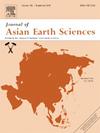New insights into the provenance and tectonic evolution of the Paleoproterozoic Aravalli Basin, NW India
IF 2.7
3区 地球科学
Q2 GEOSCIENCES, MULTIDISCIPLINARY
引用次数: 0
Abstract
The tectonic setting of the Paleoproterozoic Aravalli Basin remains a subject of debate, primarily due to limited geochemical data, which complicates the establishment of a definitive stratigraphic framework and geodynamic evolution model for the Aravalli orogen. New petrological and geochemical data of the clastic (meta)sedimentary rocks, including quartzite, wacke and metapelites, have been used to reconstruct the sedimentary provenance and tectonic evolution of the Aravalli Basin. The Aravalli quartzites show quartz dilution, most likely representing a recycled sedimentary source without any significant heavy mineral addition. In contrast, the geochemical compositions of the wackes and metapelites do not suggest any significant sedimentary sorting and reflect the chemical characteristics of the source rocks. Weathering trends in the A-CN-K diagram indicate predominantly low to moderate weathering in the source area. Some samples deviate from the predicted weathering trend, reflecting plagioclase alteration to illite (now muscovite) or K-feldspar due to post-depositional K-metasomatism. The elemental ratios (Th/Sc, Zr/Sc and TiO2/Zr) indicate that the detritus for the Aravalli sediments was largely sourced from the felsic igneous rocks. The results of REE modelling suggest that late Neoarchean (2.57–2.50 Ga) and late Paleoproterozoic (1.88–1.70 Ga) granitoids exposed in the Aravalli orogen and the adjacent Bundelkhand Craton constituted the dominant potential source rocks for the Aravalli sediments. The integration of new results, with the previously obtained igneous and detrital zircon U-Pb ages, constrain the deposition of Aravalli (meta)sedimentary sequence in a passive margin setting at <1.74–1.60 Ga.
印度北部古元古代Aravalli盆地物源与构造演化新认识
由于地球化学资料有限,古元古代Aravalli盆地的构造背景一直存在争议,这使得建立Aravalli造山带的明确地层格架和地球动力学演化模型变得复杂。利用碎屑(元)沉积岩(包括石英岩、碎屑岩和变质岩)的岩石学和地球化学新资料,重建了Aravalli盆地的沉积物源和构造演化。Aravalli石英岩显示石英稀释,很可能代表了一个再循环的沉积源,没有任何明显的重矿物添加。而碎屑岩和变质岩的地球化学组成则没有明显的沉积分选作用,反映了烃源岩的化学特征。A-CN-K图的风化趋势表明,烃源区以低至中风化为主。部分样品偏离了预测的风化趋势,反映了斜长石因沉积后钾交代作用而转变为伊利石(现为白云石)或钾长石。元素比值(Th/Sc、Zr/Sc和TiO2/Zr)表明,Aravalli沉积物碎屑主要来源于长硅质火成岩。稀土模拟结果表明,暴露于Aravalli造山带及邻近的Bundelkhand克拉通的晚新太古代(2.57 ~ 2.50 Ga)和晚古元古代(1.88 ~ 1.70 Ga)花岗岩类是Aravalli沉积物的主要潜在烃源岩。新结果与先前获得的火成岩和碎屑锆石U-Pb年龄相结合,限制了Aravalli(元)沉积序列在1.74-1.60 Ga被动边缘环境下的沉积。
本文章由计算机程序翻译,如有差异,请以英文原文为准。
求助全文
约1分钟内获得全文
求助全文
来源期刊

Journal of Asian Earth Sciences
地学-地球科学综合
CiteScore
5.90
自引率
10.00%
发文量
324
审稿时长
71 days
期刊介绍:
Journal of Asian Earth Sciences has an open access mirror journal Journal of Asian Earth Sciences: X, sharing the same aims and scope, editorial team, submission system and rigorous peer review.
The Journal of Asian Earth Sciences is an international interdisciplinary journal devoted to all aspects of research related to the solid Earth Sciences of Asia. The Journal publishes high quality, peer-reviewed scientific papers on the regional geology, tectonics, geochemistry and geophysics of Asia. It will be devoted primarily to research papers but short communications relating to new developments of broad interest, reviews and book reviews will also be included. Papers must have international appeal and should present work of more than local significance.
The scope includes deep processes of the Asian continent and its adjacent oceans; seismology and earthquakes; orogeny, magmatism, metamorphism and volcanism; growth, deformation and destruction of the Asian crust; crust-mantle interaction; evolution of life (early life, biostratigraphy, biogeography and mass-extinction); fluids, fluxes and reservoirs of mineral and energy resources; surface processes (weathering, erosion, transport and deposition of sediments) and resulting geomorphology; and the response of the Earth to global climate change as viewed within the Asian continent and surrounding oceans.
 求助内容:
求助内容: 应助结果提醒方式:
应助结果提醒方式:


